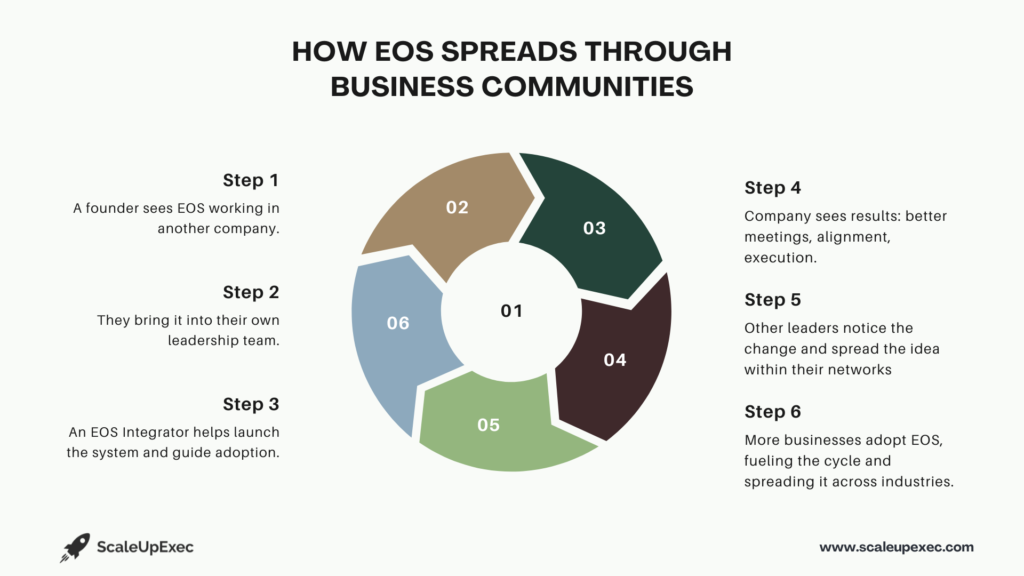The Entrepreneurial Operating System (EOS) has grown into one of the most popular business frameworks for small and mid-sized companies. Built to help leadership teams gain clarity, focus, and control, EOS is now used by thousands of companies around the world. So how many companies run on EOS?
As of today, over 100,000 companies have implemented EOS tools in some form. While not every company strictly adheres to the system, many stick to the core processes and continue to see long-term benefits. EOS is especially popular among growing teams that need structure without adding unnecessary complexity.
Why So Many Companies Choose EOS

EOS is simple, practical, and designed for real-world use. It focuses on six core components: Vision, People, Data, Issues, Process, and Traction. These parts work together to help a business get organized and stay focused.
One big reason EOS is so widely adopted is that it’s flexible. It works in many industries, including from tech startups to professional services to manufacturing. As long as the company has a leadership team and wants to scale, EOS can help. Many founders also turn to fractional COO consulting for small businesses to guide their EOS journey without committing to a full-time executive hire.
Who Typically Runs on EOS?
EOS is most commonly used by companies with 10 to 100 employees. These businesses are often in a phase of rapid growth or transition. They need structure but don’t want the bureaucracy that comes with traditional corporate systems.
Startups that adopt EOS early often build stronger foundations. They create clear roles, focus on priorities, and track progress more effectively. It’s common to see leadership teams pair EOS with fractional leadership especially when a fractional COO helps startups grow through clearer execution and better systems.
Larger companies can also benefit from EOS, especially if they’re looking to simplify operations and reconnect their teams to a shared vision.
How EOS Spreads Through a Business Community
EOS often spreads by word of mouth. A founder sees it working in another company and brings it to their own team. EOS Implementers, who are trained coaches that help launch EOS, also play a key role in helping companies adopt and stay committed to the process.
Professional groups like Vistage, EO (Entrepreneurs’ Organization), and YPO often introduce EOS to their members. Many of these business owners go on to implement EOS in their own companies and recommend it to others.

When businesses see better alignment, smoother meetings, and stronger results, it’s easy to understand why the EOS community keeps growing.
What Goes into Running EOS Effectively?
Running on EOS is more than just using a few tools. It’s a shift in how a company thinks and operates. Leadership teams need to meet weekly, track progress, and solve problems consistently. One of the most powerful tools in EOS is the Scorecard.
Leaders often ask what goes in an EOS scorecard. The answer: five to fifteen weekly numbers that measure activity and performance. These metrics are chosen based on what truly drives business results, such as sales calls, customer issues, or revenue booked. Scorecards give leadership a quick and honest view of how the company is performing.
When done right, this level of tracking helps identify issues early and keeps the whole team aligned.
Fractional Leadership and EOS

Many businesses using EOS don’t have a full-time COO, Integrator, or operations lead. That’s where fractional leadership becomes valuable. A fractional COO can act as the Integrator, managing the EOS process and holding the team accountable.
Compared to a consultant, a fractional COO gets deeply involved in daily operations. They don’t just advise; they execute. This makes a big difference in how well EOS takes hold. Businesses that invest in fractional COO consulting often see faster results and stronger adoption of the EOS system.
Why EOS Works for So Many Companies
EOS doesn’t require fancy tools or expensive software. It relies on clear goals, consistent meetings, and disciplined problem-solving. That simplicity is what makes it stick.
It’s also a system that scales. As companies grow, EOS grows with them. Teams stay aligned, communication stays strong, and leadership stays focused. For businesses that want freedom and growth at the same time, EOS offers both.
And when teams bring in strong operational leadership, they get the support they need to keep momentum going.
Final Thoughts
More than 100,000 companies have run on EOS because it works. It brings structure without slowing you down, and clarity without extra layers. For growing businesses, it creates a steady rhythm that drives progress.
If you’re building a business and looking for tools to manage growth, EOS is worth exploring. And if you’re not ready for a full-time operations leader, fractional support can bridge that gap. Whether you’re just starting EOS or looking to go deeper, combining it with fractional COO consulting can help you stay focused, accountable, and ready to scale.
More than 100,000 companies run on EOS, but results vary depending on who’s leading the process.
ScaleUpExec fractional COOs bring the kind of proven operating experience that most SMBs can’t access full time. We combine EOS discipline with hands-on execution to keep growth on track—at a fraction of the cost of a full-time hire. Reach out to us at ScaleUpExec to talk about your EOS journey.







